#Scottish Crown jewels
Text
Looking for Castle Paravel
I do love a castle by the sea - Tom had Harry Potter, we had The Lion the Witch and the Wardrobe. I've visited Dunluce Castle, which inspired C.S. Lewis, but Dunnottar Castle, south of Aberdeen, is even better.

Added to that, it has a romantic civil war history, being the place where the Earl Marischal was besieged with the Scottish crown jewels, managing to smuggle them out, where they were hidden in nearby Kinneff church until the Restoration.
The Marischal had a suitably royalist set of mottos.


2 notes
·
View notes
Text

Castle intrigue
Tickets in hand, we breached the famous Edinburgh Castle Friday; there it is, rising from Castle Rock, which has been occupied by humans since at least the Iron Age (1200-550).
It has everything one could want in a castle - cannons, suits of armor, nooks and crannies galore, the oldest Crown Jewels in Britain ...
Speaking of which ... I got to chatting - gossiping, actually - with one of the castle guards about Rod Stewart, the British singer and songwriter, who was in Edinburgh recently to perform at the city's annual Royal Edinburgh Military Tattoo festival .
"He's such a diva," said the guard, like a man eager to get something off his chest. Oh really ...? Do tell.
Stewart, it seems, was demanding in all kinds of ways while touring the castle. Most notably, he insisted on taking a photo of the Scottish Crown Jewels, which, for security reasons, is strictly prohibited.
When Stewart was told the jewels were off-limits for photos, he allegedly said, "But I'm Rod Stewart." The person in charge, according to the guard, told Steward, "I don't care if you're the king."
Stewart didn't get his photo.
12 notes
·
View notes
Text
youtube
0 notes
Text
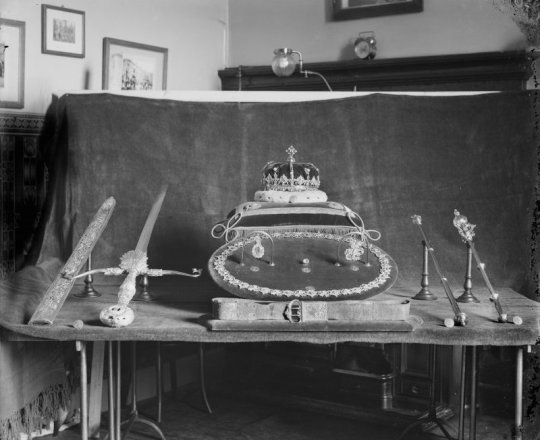


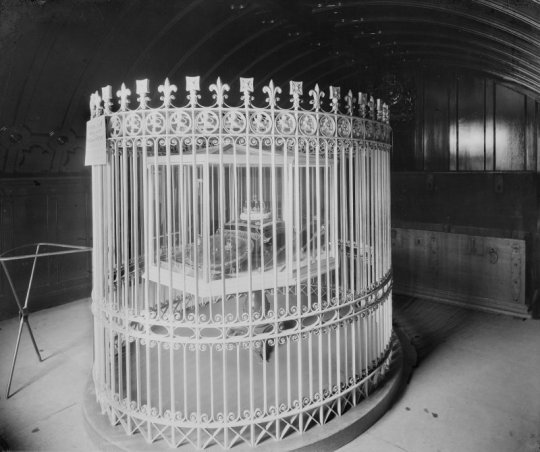
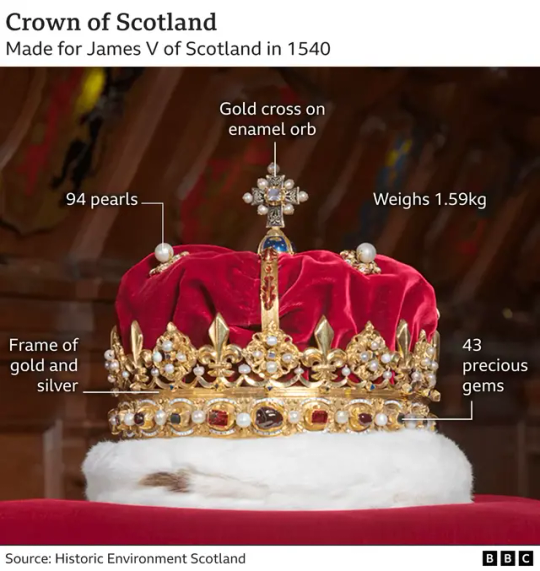

On 26th May 1819, the Honours went on public display in the Crown Room in Edinburgh Castle.
The ‘Honours’, our Crown Jewels, were first used together at the coronation of the nine-month-old Mary, Queen of Scots in 1543, the Crown almost certainly dates from before 1540 when it was remodelled by order of James V. It was last worn at the coronation of Charles II at Scone in 1651, the last time a monarch was crowned in Scotland.
Made of solid silver, the Sceptre is surmounted with three figures supporting a crystal globe, a cut and polished rock crystal, with a Scottish pearl on top. A gift from the Pope, possibly given by Innocent Vlll to James IV in 1494, again it was remodelled by James V who even added his initials to the sceptre, the Stewarts were a vain lot.
The Sword of State was presented to James IV in 1507 by Pope Julius II and has a blade a metre long.
Following the Treaty of Union in 1707, the ancient Honours were not seen for a century. Rumours circulated that the English had removed them to London. However Sir Walter Scott asked for permission to seek them out in in 1818. And as he suspected they were found in a chest hidden away.
They have remained on secure display ever since, except for the duration of World War II.
The Honours have since been joined by other royal regalia and jewels of a personal nature – the Wand (found in the Chest in 1818), the Stewart Jewels (presented by William IV in 1830) and the Lorne Jewels (bequeathed by Princess Louise in 1939) – and by the Stone of Destiny (see separate Statement), which was returned from Westminster Abbey in 1996 after it as stolen by Edward I (Longshanks) Scotland ove700 years before.
Below is a lengthy rundown of the Honours as marked down in history, please note though that the earliest dates are only noted in history some of the original Honours were lost by the English.
574: First reference to a royal sceptre, by Cumméne ‘the White’, seventh abbot of Iona, in connection with the inauguration by St Columba of Aédán mac Gabhráin as king of the Scots of Dál Riata.
1097: King Edgar is depicted on his seal wearing a crown, and holding a sceptre and sword.
1157: David I is depicted in a posthumous charter holding an orb in place of a sceptre.
1182: William I ‘the Lion’ is presented with a golden rose by Pope Lucius II.
1296: Edward I of England strips John I (Balliol) of his crown, sceptre and sword and takes them, together with the Stone of Destiny, to England, where they are subsequently lost or destroyed.
1306: Robert I (Bruce) is enthroned at Scone with a new circlet of gold.
1329: Pope John XXII formally recognises the right of kings of Scots to be formally crowned and anointed, hitherto denied them on account of English opposition.
1331: David II, Robert I’s heir, is formally crowned and anointed at Scone.
1484: Coin evidence (a silver groat) indicates that the crown, hitherto a simple open circlet, has by now become an ‘imperial’ crown (ie, closed with arches).
1486: James III is presented with a golden rose by Pope Innocent IV.
1491: James IV is presented with a golden rose by Pope Innocent VIII.
1494: Tradition has it that the Sceptre was presented to James IV by Pope Alexander VI. However, it is possible that the Sceptre was presented with the golden rose in 1491.
1503: James IV is depicted in the Book of Hours , made to commemorate his marriage, wearing an ‘imperial’ crown. Also, first mention of a crown bonnet.
1507: The Sword of State is presented to James IV by Pope Julius II. A consecrated, or blessed, hat is presented at the same time.
1532: The bonnet is renewed and the crown repaired by Thomas Wood, goldsmith.
1536: The Sceptre is lengthened and embellished for James V by Adam Leys, an Edinburgh goldsmith, perhaps in preparation for his first marriage, to Princess Madeleine de Valois. This enhancement is formally acknowledged when the Crest above the Royal Arms is amended, the Sceptre replacing the Saltire in the lion’s left paw.
1539, the crown is refashioned to its present form for James V by John Mosman, Edinburgh goldsmith. James wears it for the first time at the coronation of his second wife, Mary of Guise, in Holyrood Abbey. The purple velvet bonnet, made by Thomas Arthur, has not survived, but its four delicate ornaments have.
1543: Mary Queen of Scots is crowned in Stirling Castle, the first sovereign to be enthroned with all three Honours. 1
560: Queen Mary receives a golden rose from Pope Pius IV. 1567: James VI is crowned with the Honours in the Kirk of the Holy Rude, Stirling.
1571–73: Substitute Honours are used at sittings of Parliament, because Edinburgh Castle is in the hands of the supporters of the exiled Queen Mary.
1615–16: The Crown Room is created, part of the wholesale remodelling of the Palace in preparation for James VI’s ‘hamecoming’ in 1617. The present Crown Chest is very probably also made at this date.
1633: Charles I is crowned in Holyrood Abbey with the Honours
1638–39: The Honours are taken to Dalkeith Castle for safe-keeping during the conflict between Charles I and those supporting the National Covenant.
1650: The Honours are removed from the castle, possibly to Stirling Castle, for safe-keeping, prior to Oliver Cromwell besieging the castle.
1651: Charles II is crowned with the Honours at Scone. Following the ceremony, the Honours, unable to be brought back to Edinburgh Castle, are taken to mighty Dunnottar Castle, Kincardineshire, seat of the Earl Marischal.
1652–60: The Honours are smuggled out of Dunnottar and buried under the floor of nearby Kinneff Kirk. On Charles II’s return to the throne, the Honours are returned to Edinburgh Castle: all except the Sword belt and Crown cushion.
1687: James VII has the crown bonnet changed from purple to red.
1707: Following the adjourning of Parliament after the passing of the Act of nion.
1790: The Sword Belt is discovered hidden in a wall at Barras, near Dunnottar Castle, by Sir David Ogilvy.
1794: Lieutenant-Governor Major Drummond briefly opens the Crown Room in search of old Parliamentary records but, because he lacks the necessary royal warrant, does not break open the Crown Chest.
1818: Walter Scott and others, with a royal warrant from the Prince Regent, officially break into the Crown Room, break open the Crown Chest and there rediscover the Honours, together with a wand, or baton of office. A second royal warrant appoints the Commissioners for the Keeping of the Regalia (Keeper of the Great Seal, Keeper of the Privy Seal, His Majesty’s Advocate, the Lord Clerk Register and the Lord Justice Clerk). Scott’s friend Adam Ferguson is appointed Keeper of the Regalia, with a ‘grace and favour’ flat above the Crown Room.
1819: The public are invited to inspect the Honours in the Crown Room, on payment of an admission fee.
1822: George IV (the former Prince Regent) formally visits Scotland, and the Honours are taken to the Palace of Holyroodhouse for the duration of his stay.
1830: The Stewart Jewels, bequeathed to George III in 1807 by Prince Henry, Cardinal York, the last Stuart claimant to the throne of Great Britain, are entrusted by William IV into the safe-keeping of the Keeper of the Regalia for display in the Crown Room.
1837: The Turkish Ambassador is denied entry to the Crown Room because he does not have an admission ticket!
1842: The Honours are temporarily removed to an adjacent room so that they may be better viewed by Queen Victoria and Prince Albert.
1848: The present panelling is installed in the Crown Room by the Edinburgh firm of Charles Trotter, cabinetmakers and joiners.
1871: The Honours are redisplayed behind a cage of ornamental bars, for their better security.
1892: The Sword Belt is returned to the Crown Room from Barras Castle, Kincardineshire, by Rev. Samuel Ogilvy Baker, a descendant of Sir David Ogilvy.
1905: The old Crown Cushion is presented to the State by Sir Patrick Keith Murray, who states that it had been retained at Dunnottar by his ancestor, Sir William Keith, 9th Earl Marischal, after the Honours had been smuggled out in 1652
1911: The Sword is taken to St Giles’ Cathedral for the official opening of the Thistle Chapel. Gyp, the Crown Room dog, dies and is buried in the Dog Cemetery below St Margaret’s Chapel.
1939: Princess Louise, Queen Victoria’s fourth daughter, bequeaths the Lorne Jewels, presented to her by Clan Campbell on the occasion of her marriage to the Marquis of Lorne in 1871, to the Scottish nation, and they are added to the display in the Crown Room. Shortly thereafter (1 September), the Crown Jewels are taken down to the basement of the Palace to protect them from aerial bombardment by German planes.
1942: The Honours are secretly taken out of the basement and buried in David’s Tower, where they remain for the duration of WWII.
1953: The Honours are presented to Her Majesty Queen Elizabeth at the National Service of Thanksgiving in St Giles’ Cathedral that follows the Coronation in Westminster Abbey.
1971: The Sword of State is used for the first time at the ceremonial installation of a Knight of the Most Ancient and Most Noble Order of the Thistle, Scotland’s premier Order of Chivalry, held in the Thistle Chapel, in St Giles’ Cathedral.
1980s: The post of Warden of Regalia is abolished. 1
987: The Sword of State is used alone for the final time, in St Giles’ Cathedral for the tercentenary anniversary celebrations of the Order of the Thistle. Thereafter, in view of its parlous condition, its ceremonial role is restricted to National Services of Thanksgiving
1993: Her Majesty Queen Elizabeth formally opens the Honours of the Kingdom exhibition, including the extensively refurbished Crown Room and redisplayed Honours. The present Crown Cushion is made specially for the occasion. The Crown Chest is relocated from the Crown Room to an adjacent exhibition space and displayed alongside one of the original padlocks, broken in 1818.
1999: The Crown is formally taken to the State Opening of the Scottish Parliament, the first in the modern era.
2022; The Crown of Scotland was placed on Elizabeth II's coffin at a service in St Giles' Cathedral.
2023; The Honours of Scotland were presented to King Charles III in a ceremony held in St Giles' Cathedral. The ceremony was formally described as a National Service of Thanksgiving and Dedication to mark the coronation of King Charles III.
36 notes
·
View notes
Text
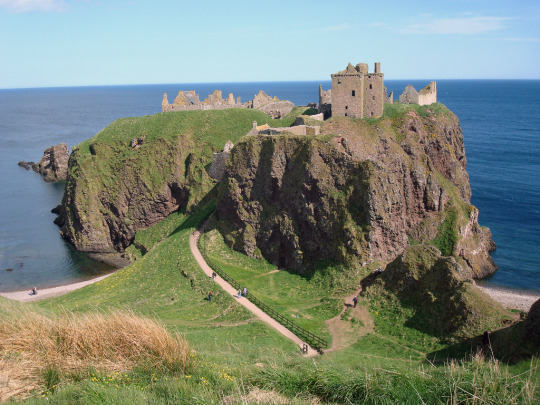
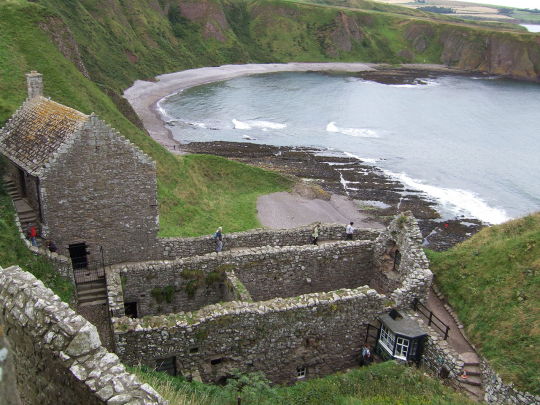
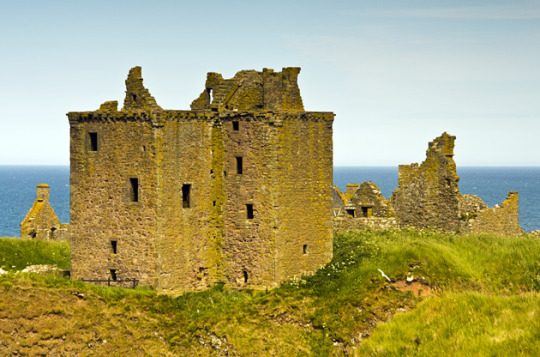

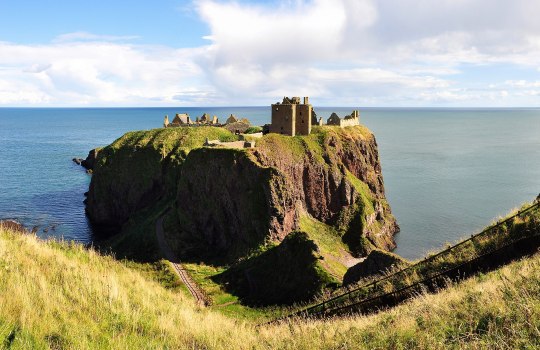

Dunnottar Castle, "fort on the shelving slope" is a ruined medieval fortress located upon a rocky headland on the north-eastern coast of Scotland, about 2 miles (3 kilometers) south of Stonehaven. The surviving buildings are largely of the 15th and 16th centuries, but the site is believed to have been fortified in the Early Middle Ages. Dunnottar has played a prominent role in the history of Scotland through to the 18th-century Jacobite risings because of its strategic location and defensive strength.
Dunnottar is best known as the place where the Honours of Scotland, the Scottish crown jewels, were hidden from Oliver Cromwell's invading army in the 17th century. The property of the Keiths from the 14th century, and the seat of the Earl Marischal, Dunnottar declined after the last Earl forfeited his titles by taking part in the Jacobite rebellion of 1715. The castle was restored in the 20th century and is now open to the public.
The ruins of the castle are spread over 1.4 hectares (3+1⁄2 acres), surrounded by steep cliffs that drop to the North Sea, 160 feet (50 meters) below. A narrow strip of land joins the headland to the mainland, along which a steep path leads up to the gatehouse. The various buildings within the castle include the 14th-century tower house as well as the 16th-century palace.
(source)
607 notes
·
View notes
Text
MY NAME IS MY NAME IS MY NAME IS CHARLES SECOND I LOVE THE PEOPLE AND THE PEOPLE LOVE ME SO MUCH THAT THEY RESTORED THE ENGLISH MONARCHY I'M PART SCOTTISH, FRENCH, ITALIAN A LITTLE BIT DANE BUT ONE HUNDRED PERCENT PARTY ANIMAL CHAMPAGNE?? SPANIELS I ADORED NAMED AFTER ME TOO LIKE ME, THEY WERE FUN WITH A NUTTY HAIR DO! IS TODAY MY BIRTHDAY? I CAN'T RECALL LET'S HAVE A PARTY ANYWAY
BECAUSE I LOVE A MASKED BALL!
ALL HAIL, THE KING! OF BLING! LET'S SING! BELLS RING! DING DING! I'M THE KING WHO BROUGHT BACK PARTYING! KING CHARLES, MY DADDY
LOST HIS THRONE AND KINGS WERE BANNED THEY CHOPPED OFF HIS HEAD THEN OLLY CROMWELL RULED THE LAND OLD OLLY WASN'T JOLLY HE WAS GLUM, AND HE WAS PROUD WOULD BE MISERABLE AS SIN ONLY SINNING'S NOT ALLOWED! WHEN OLLY DIED, THE PEOPLE SAID 'CHARLIE, ME HEARTY! GET RID OF HIS DULL LAWS COME BACK, WE'D RATHER PARTY! 'THIS ACTION'S WHAT THEY CALLED THE MONARCHY RESTORATION WHICH NATURALLY WAS FOLLOWED BY A HUGE CELEBRATION!THE KING OF ENG! NO SIN! TOO SING! OR ANYTHING! ALL SAY, I'M THE KING WHO BROUGHT BACK PARTYING!
GREAT LONDON FIRE WAS A WHOPPER! IN MY REIGN, LONDON CITY CAME A-CROPPER! SO THIS KING DID WHAT WAS RIGHT AND PROPER FOUGHT THE FIRE, PROVED I'M MORE THAN A BOPPER I'M A FIRE STOPPER! MARRIED CATHERINE BRAGANZA SHE WAS A LOVE SO TRUE THERE WOULD NEVER BE ANOTHER WELL... MAYBE ONE OR TWO! LUCY WALTER, NELL GWYNNE MOLL DAVIES, BARBARA VILLIERS YOU THINK THAT'S BAD BUT HER NAME'S NOT AS SILLY AS...HORTENSE MANCINI! AS KING, I MUST ADMIT I BROKE THE WEDDING RULES BUT WHO CARES WHEN I BROUGHT BACK THE CROWN JEWELS? I REINSTATED CHRISTMAS MAKE UP, SPORTS AND EVEN PLAYS I WAS THE MERRY MONARCH THEY WERE GOOD OLD DAYS!
WHEN SAID AND DONE! KING CHARLES DID RUN! ENGLAND FOR FUN! I WAS THE KING LOVED BY EVERYONE MY SONG IS DONE!
party anyone?
151 notes
·
View notes
Text
"Royal Family persuaded Queen to end her days at Balmoral"
Princess Royal discloses Elizabeth II feared making life difficult if she died in Scotland
by Hannah Furness, Royal Editor
The late Queen was persuaded to spend her final days at Balmoral as she and the Royal family made preparations for her death, it has emerged.
Queen Elizabeth II had initially feared "it would make things more difficult" if she died at her beloved Scottish home, the Princess Royal has disclosed. Her family eventually convinced her to put her own comfort before her concern for others after a lifetime of duty.
Speaking of her mother's last days in a BBC documentary about the coronation of King Charles III, the Princess described how the family had tried to persuade her that practical issues "shouldn't be part of the decision-making process".
It is the first time the Royal family has spoken of arrangements for the late Queen's death.
Queen Elizabeth II died peacefully at Balmoral in Scotland on Sept 8 last year, aged 96, after reigning 70 years.
She had extended her annual summer stay at the Aberdeenshire estate, where the Prime Minister asked to travel to Scotland to spare her the journey back to Buckingham Palace for what turned out to be her final engagement.
Her children, grandchildren and great-grandchildren had visited Balmoral over the summer, as concern for her health grew. The Duke of Sussex and his family did not make the trip, having fears over their security.
At the time, the palace described the Queen as having "episodic mobility problems", with a series pf cancelled engagements in early 2022 giving way to a peaceful summer without expectation she would appear in public.
In September, she invited Liz Truss, her 15th prime minister, to form a government from Balmoral, breaking with a lifetime of holding the audience in London or Windsor. Then, it was said the Queen had been advised not to travel, with plans for Boris Johnson and Ms Truss to make the 1,000-mile round trip to Scotland instead.
Now, speaking in the documentary, the Princess Royal has paid loving and characteristically practical tribute to her mother.
"We always enjoyed being at Balmoral", she says in a programme to be broadcast on Boxing Day. "We spent a lot of time there in our youth and a lot of it was probably a more independent life than anywhere else. I think there was a moment where she felt it would be more difficult if she died at Balmoral. I think we did try to persuade her that that shouldn't be part of the decision-making process. So I hope she felt that was right in the end, because we did".
The Princess was the only member of the Royal family to be at Balmoral when it became clear the Queen was entering her final hours.
The then Prince of Wales and Duchess of Cornwall made an emergency journey from Dumfries House in Ayrshire, with other senior members of the family arriving after she had died.
Speaking of the moment at St. George's Chapel when the Crown Jeweller removed the crown, orb and scepter from her coffin, the Princess told BBC One programme Charles III: The Coronation Year: "When he takes the crown off the coffin, I rather weirdly felt a sense of relief. Somehow that's it, finished. That responsibility being moved on".
Speaking of her brother, who became King instantly, she added: "To be honest, I'm not sure that anybody can really prepare themselves for that kind of change. At least no easily. And then the change happens and you go OK, I know need to get on with it".
The documentary will share behind-the-scenes footage of the King's preparation for his Coronation in May.
The Princess Royal is the only member of the Royal family to be interviewed on camera. The Prince of Wales and the Duke of Edinburgh appear in footage, with no sign of the Duke of Sussex or Duke of York.
103 notes
·
View notes
Text




The largest Scottish river pearl found in living history, the Abernethy Pearl is a remarkably perfect example, found in 1967 by Scotland’s last pearl fisherman, William (Bill) Abernethy.
There has always been an allure which has drawn mankind to natural pearls, be they saltwater or freshwater, and since antiquity, civilisations have valued them for their physical, and often mystical properties. The Ancient Greeks believed they would ensure marital bliss when worn by a bride on her wedding day, while the Romans believed they could provide a long and healthy life.
Our frenzy for these natural treasures reached a true crescendo in the early 20th century, when they became the ultimate signifier of wealth and status. Such was the case in the US when, in 1917, keen to acquire the natural pearl necklace his wife had seen at Cartier, the New York financier Morton Plant exchanged the jewel for his 5th Avenue townhouse. The prestigious central Manhattan location remains Cartier’s flagship American Maison to this day.
In Scotland, the pearl has had an illustrious history, and if natural saltwater pearls are a rarity, the natural Scottish river pearl is something else indeed. It is believed that only one in every five thousand mussels found in Scottish rivers contains a pearl, and generally they are smaller than their saltwater cousins. Today the mussels (Margaritifera margaritifera) in which Scottish pearls grow are dangerously close to extinction and are rightly a protected species.
Historians have postulated that the desire for Scottish pearls was one of Julius Caesar’s incentives for his invasion of Britain in 55BC; he was known as an avid pearl collector. Indeed, the popularity of these rare specimens continued into the Victorian era, fuelled by Queen Victoria’s passion for all things Scottish. The largest Scottish river pearl ever found, the famous Kellie Pearl, is set on the Crown of Scotland which dates to the 1540s. It remains housed and on view to visitors at Edinburgh Castle today.
William (Bill) Abernethy
William (Bill) Abernethy, famously known as Scotland’s last pearl fisherman, seems to have understood the danger of the demand for these rare specimens intuitively. In 1967 he found the now famous Abernethy Pearl, second only in fame to the aforementioned Kellie Pearl, and though he never disclosed where exactly he found it (likely to discourage fortune hunters trying their own luck), it was purportedly wrapped in a dock leaf to keep it from scratching, before he took it to jewellers Cairncross of Perth, where it remained until recently.
As the largest Scottish river pearl found in living history, weighing 43.6 grains, the Abernethy Pearl is a remarkably perfect example. Bill had been trained how to fish for pearls by his father, and had a rare understanding of the mussels and the rivers in which they could be found. During the 1970s, wildlife cameraman Doug Allen worked with Bill as a pearl diver, and in Bill’s 2021 obituary he noted how he was able to discern from the size and shape of the mussel as to the likelihood of it containing a pearl; enabling him to pick carefully and leave undisturbed many of the other mussels, better maintaining their numbers and health.
It is believed the Abernethy Pearl (affectionately known as ‘Little Willie) could have been quietly growing in its mussel for over 80 years before it had been found by Bill. It is interesting to think that 80 years prior to Bill plucking it from the water, was the Golden Jubilee year of 1887, evoking images of Queen Victoria tramping the heather with her pony Fyvie and servant John Brown while the pearl was quietly growing.
Lyon and Turnbull
29 notes
·
View notes
Text

Three students from King Charles's old school, Gordonstoun will be among the pipers welcoming the Royal Family to St Giles Cathedral, Edinburgh on Wednesday 5th July 2023, when the Scottish Crown Jewels will be presented to the King.
121 notes
·
View notes
Text
Hi everyone! I recently visited the beautiful coastal town of Stonehaven near Aberdeen in the north east of Scotland, with its lovely beaches, and then took a walk over to the stunningly located Dunnottar Castle - one of the most picturesque I've seen and one of my favourites! 😍
Dunnottar Castle has played a large part in Scottish history for over 1000 years and hosted some of the nation's greatest historical figures including William Wallace and Mary Queen of Scots, is famous for its role in saving the Honours of Scotland (the Scottish Crown Jewels) from Oliver Cromwell's army in the 1650s.
@doricloon @scotlandscalling @scotianostra @scotland-forever
youtube
#youtube#walking tour#scotland#visitscotland#edinburgh#landscape#tourism#outdoors#nature#town centre#stonehaven#dunnottar#dunnottar castle#aberdeen#beach#coastal path#coastal#coast#east coast#castle ruins#castle#coastal walk#seaside walk#seaside#seaside views#coastal town#glasgow#beautiful views#travel recommendations#travel video
9 notes
·
View notes
Text
The Rings of Power Liveblog: Adrift (Episode 2)
In between watching the first and second halves of this episode, I was looking back through the Appendices and realized that the events this series covers, from the reemergence of Sauron in Middle-earth to the eventual forging of the various Rings, span 1200 years! So it’s kind of absurd to think of them somehow adapting those events “accurately” (which makes you wonder why they made some of the narrative choices they did…).
The idea of Galadriel swimming back across the sea to Middle-earth is laughable, but tbh what else can she attempt to do in this situation?
The fire around the Stranger isn’t hot because…magic, I guess?
Nori’s a darling.
Arondir is being all self-sacrificing and stupid noble by going to explore the scary tunnels alone…good thing he probably has plot armor.
People who haven’t read The Silmarillion: Who the fuck is Fëanor? What are the Silmarils?!?
Helpfully, Elrond tells us that they were “the jewels that contain the very light of Valinor.” Oversimplified, sure, but that’s the kind of exposition the first episode needed: Tolkien 101 for people who know nothing about Tolkien (beyond, probably, some movies)!
As someone who can’t roll their Rs, the aggressively exaggerated pronunciation of “Sauron,” “Morgoth,” and now “Silmaril” makes me feel…kind of inept.
That said, a) do they even have the rights to tell this Morgoth story? and b) exposition between two characters who already know it (and I guarantee that Elrond knows the story Celebrimbor is telling rn…) is mildly annoying.
Elrond Half-elven, “as noble and fair as an elf-lord, as strong as a warrior, as wise as a wizard, as venerable as a king of dwarves, and as kind as summer” a Kiss-ass

Good set design! Tbh, I wish Rivendell had been portrayed more like this in the PJ movies: a little richer, with more wood and warm golden light.
Why is Celebrimbor in such an arbitrary hurry to build this forge? A few months is nothing to an Elf!
“How far outside [our own race]?” Well, I just don’t know, Celebrimbor, who else in Middle-earth is renowned for their metallurgy? Which race has yet to be portrayed in this—oh, right.


Please book me a trip to Middle-earth.
“Their prince, Durin, is an old and dear friend.” And yet Elrond, one of the wisest people in Middle-earth, doesn’t know what “Durin’s Day” is when it comes up in The Hobbit. If he had a near-fraternal bond with a Dwarf prince, wouldn’t he be aware of significant Dwarven holidays?
I know this Elrond is just supposed to be younger and less experienced, but he’s coming across as kind of dumb.

Khazad-dûm looks incredible.
So the Dwarves have Scottish accents, the Harfoots Irish, and the Elves English? But the Men also have English accents, just less refined? Hmm. Choices were made.

I would die for her nbd. ♥

Gee, I wonder why everyone is speculating about Gandalf.
“Looks can be deceiving.” Given that I know who this character turns out to be, this dialogue is a little…heavy-handed.
The whole water dragon (?) sequence was so silly. Just like the “ice troll”.
It’s almost like “Elrond is besties with this Dwarf prince” subplot was a bad idea cooked up only to create some pointless, petty interpersonal conflict. It also makes it painfully obvious that there’s no reason Celebrimbor, an Elf, would be in a big hurry to build anything.
“Gamli” is the really best name they could come up with for Durin’s son? Pretty sure Durin’s son was also named Durin. I cross-checked the Appendices and could not find a “Gamli” anywhere…
Do Durin and Disa, the crown prince and princess of Khazad-dûm, have no servants? They’re just welcoming a guest into their house, fussing with their children, and serving dinner like regular folk. Where is a single one of the dozens of extras that we just saw in a previous scene??
What is it with the tendency of Tolkien adaptations to show the Dwarves as less than dignified? (i.e., Durin belching loudly at the dinner table.) Gimli was reduced to comic relief, and the Dwarves in the Hobbit films who aren’t meant to be seen as goofy—Thorin, Fili and Kili—are much more like Men than the other Dwarves. Tolkien felt VERY strongly about Dwarves being a proud and noble race! Respect that!!!
“Aulë’s beard!” I love this. (People who haven’t read the Silmarillion: Who’s Aulë?!)
“I am simply wondering what manner of man would so readily abandon his companions to death.” Big Elizabeth Swann energy.
There are so many problems with making this character a hot human dude. I’m glad I already know the truth about his identity, though—I don’t have to come around to “Halbrand” or (even worse) start shipping him with Galadriel. I can just be indignant.
Based on what we know about the duplicitous behavior as [redacted], you’d think Halbrand would be a little bit more…suave? Charming? Anything but this blunt, confrontational asshole.
People sure can cover ground quickly in Middle-earth. Unbelievably fast travel for the sake of moving the story along is a problem in almost all fantasy TV shows, mind you. If they only budgeted for 10 episodes instead of 8…or even (gasp) 13…
Why do Orcs look like straight-up horror movie villains now?
Also it’s so convenient that this Orc appeared beneath Bronwyn’s house on the same day she tried to convince her fellow villagers about the Orc tunnel threat.

Their pathetic little raft wouldn’t survive this, lol.
WHY does Halbrand save Galadriel? Repeatedly?? Did they think about this at all? There is nothing human, selfless, or compassionate about [redacted], lmfao.

As magical as this looks, Nori and Poppy’s “firefly” lanterns aren’t flickering, and anyone who’s ever seen fireflies knows that their glow isn’t consistent. They blink individually.
Same, Poppy. I also get freaked out when I see a firefly die.
The Appendices tell us that the Dwarves came to the military aid of the Elves and that they were as closely allied with Celebrimbor/Eregion as at any time in their shared history. So why are they making King Durin such a bullheaded, racist prick? (I know: for drama.)
Is the narrative implying that the shining object in King Durin’s chest is…what, a Silmaril? Because it sure as fuck shouldn’t be.
No, little emo kid, don’t take the broken Sauron sword that will surely attract evil to your people as they flee their village!
Bronwyn’s entire village is pretty easy to scare despite their generally gruff attitudes, aren’t they? At least they’re not completely stupid/have some sense of self-preservation.
The Good:
There’s still some stunning imagery to be had in this one, namely Khazad-dûm and the surrounding mountains
Likewise, some really nice set design in Eregion and especially Khazad-dûm
Nori!!!
A little exposition for non-readers (though maybe still not enough)
The Bad:
Most of the acting was weaker than in first episode, not that the writers gave anyone much to work with
Weak writing throughout: the dialogue’s not great. The characters’ motivations/choices don’t make much sense. Most of the scenarios they find themselves in vary from illogical (Elrond, Arondir) to unbelievable (Galadriel).
Why is the Stranger—Gandalf or Radagast or whoever he is—mute? And why does Nori keep assuming that she can understand/communicate with him??
No respect for the Dwarves, as usual
Too much stuff is convenient or coincidental, i.e., the perfectly-timed Orc appearance in Bronwyn’s house and the improbable survival of Halbrand’s raft
Meaning no disrespect to gamers, there were more “video game” type scenes—specifically, the water “dragon” and the Orc in Bronwyn’s house—which added nothing to the story and told us anything about the characters.
Halbrand. Yes, I am biased by knowing the twist.
I didn’t feel like this episode was that much worse than the first while I was watching it, but after reading over this, it’s obvious that it was quite a step down in quality. The first one felt, in most places, like a heartfelt homage to Tolkien’s world in ways this one just didn’t. But I love Nori to bits, and the visuals are still amazing, so I will persevere.
5 notes
·
View notes
Text





National Service of Thanksgiving and Dedication To The Coronation Of King Charles III And Queen Camilla
EDINBURGH, SCOTLAND - JULY 05: Princess Anne, The Princess Royal at the Palace of Holyroodhouse following a National Service of Thanksgiving and Dedication to the coronation of King Charles III and Queen Camilla at St Giles' Cathedral on July 5, 2023 in Edinburgh, Scotland. During the service of thanksgiving and dedication for the Coronation of King Charles III and Queen Camilla, the Honours of Scotland (the Scottish crown jewels) are presented to the new King. The service is based on a similar service held at St Giles' 70 years ago to mark the coronation of Queen Elizabeth II but unlike the 1953 service, the Stone of Destiny, on which ancient Scottish kings were crowned, will be present in the cathedral. (Photo by Lesley Martin - Pool/Getty Images)
#princess anne#princess royal#brf#britishroyalfamily#princessanne#her smile ❤️❤️#ray of sunshine#king charles the third#badass princess#i love her sm
40 notes
·
View notes
Text

Dunnottar Castle (Scottish Gaelic: Dùn Fhoithear, "fort on the shelving slope") is a ruined medieval fortress located upon a rocky headland on the north-eastern coast of Scotland, about 2 miles (3 kilometres) south of Stonehaven. The surviving buildings are largely of the 15th and 16th centuries, but the site is believed to have been fortified in the Early Middle Ages. Dunnottar has played a prominent role in the history of Scotland through to the 18th-century Jacobite risings because of its strategic location and defensive strength.
Dunnottar is best known as the place where the Honours of Scotland, the Scottish crown jewels, were hidden from Oliver Cromwell's invading army in the 17th century. The property of the Keiths from the 14th century, and the seat of the Earl Marischal, Dunnottar declined after the last Earl forfeited his titles by taking part in the Jacobite rebellion of 1715. The castle was restored in the 20th century and is now open to the public.
The ruins of the castle are spread over 1.4 hectares (3+1⁄2 acres), surrounded by steep cliffs that drop to the North Sea, 160 feet (50 metres) below. A narrow strip of land joins the headland to the mainland, along which a steep path leads up to the gatehouse. The various buildings within the castle include the 14th-century tower house as well as the 16th-century palace. Dunnottar Castle is a scheduled monument, and twelve structures on the site were listed buildings.
4 notes
·
View notes
Text
Dear Mr Cleverly

I wrote a CtM AU a while back called the Crown Jewels.
It relocated the whole CtM crew into the current rural/industrial malaise that is the North East of England.
And I thought I’d let it be.
The new UK Home Secretary who I believe is you, on the day parliament receives the largest media exposure, said that the town I’d chosen to base my fic on was and I quote from parliament, “A sh*t hole”
I’ve been inundated since with a huge mail bag from residents explaining why Poplar-on- Tweaven isn’t a sh*t hole.
A pub landlord, a person of the aristocracy, the religious community, the celebrity owners of an alpaca farm, a brewery owner, a care foundation, the local constabulary, some students, a very vexed red headed Scottish person and Trixie (she needs no introduction) have all written letters addressed to…
Dear Mr Cleverly,
I am in receipt of these letters awaiting further instruction.
14 notes
·
View notes
Text

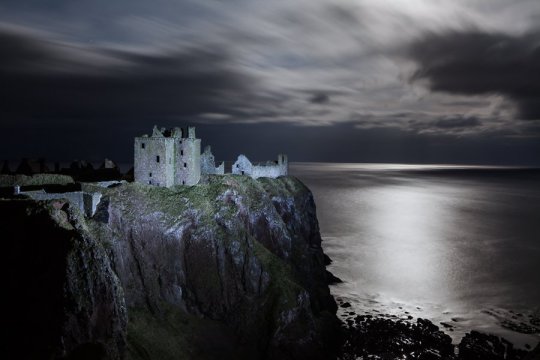


31st March 1652 saw the Honours of Scotland saved from Cromwell's forces at Dunnottar Castle.
In 1651, during Cromwell’s occupation of Scotland after his victory at Dunbar in 1650, our crown jewels The Honours of Scotland were spirited from there and used at the coronation at Scone of Charles II as King of Scots. From there they were taken for safekeeping to Dunnottar Castle. It was on March 31st when Cromwell’s troops laid siege to the castle this story happened.
The Honours of Scotland were made up of the crown, the sceptre, and the sword of state. The gold crown, decorated with gems and pearls, was made from Scottish gold, and the sceptre was a gift from Pope Alexander VI to James IV, while the sword was also a papal gift to James IV, presented by Pope Julius II. The regalia were used for the coronation of Scottish monarchs from Mary Queen of Scots in 1543 until Charles II in 1651.
The story began in 1651, following the crowning of Charles II at Scone, in Perthshire. 38 kings of Scots had been inaugurated and crowned at Scone, on top of Moot Hill, but Charles II was to be the last. Oliver Cromwell’s army by this time were marching through the Lothians, near Edinburgh, and were intent on capturing the crown jewels and destroying them, just as they had done to the English crown jewels.
The Honours and some Royal papers were brought to Dunnottar Castle for safe keeping by Katherine Drummond, hidden in sacks of wool. Sir George Ogilvie of Barras was appointed lieutenant-governor of the castle, and given responsibility for its defence. By November 1651, they were being besieged by Cromwell’s army and it was obvious to the small garrison that the castle would be captured sooner or later.
Elizabeth Douglas, wife of Sir George Ogilvie, and Christian Fletcher, wife of James Granger, minister of Kinneff Parish Church hatched a plan that saved the royal regalia. Firstly, the king's papers were removed from the castle by Anne Lindsay, a kinswoman of Elizabeth Douglas, who walked through the besieging force with the papers sewn into her clothes. Then over the course of three visits to the castle, Christian Fletcher carried away the crown, sceptre, sword and sword-case hidden amongst sacks of goods. Fletcher and her husband then buried them under the floor of Kinneff Parish Church.
For eight years the Honours were kept at the church in secret, with Cromwell scouring the country and believing the rumours that the jewels may have been smuggled abroad. Once every three months the Regalia were dug up at night to be aired before a fire and preserved from damp and injury. Wrapped in fresh cloths, they were buried again.
At last, during the Restoration of Charles II in 1660, the honours were removed from Kinneff Church and returned to the king. Christian Fletcher was awarded 2,000 merks by Parliament as a reward for saving the Honours. Parliament noted that the award was “because she was most active in conveying the royal honours…out of the castle…and that by her care the same was hid and preserved.” However, the sum was never paid!
13 notes
·
View notes
Text
Edinburgh part 1
Monday we visited Edinburgh Castle. It’s perched way above the city on a steep rocky hill, you can see it from everywhere. In these first pictures you can see the tiny stone buildings up in the air behind us.


We climbed a long winding steep road and slowly got closer and closer. We arrived at the castle portcullis gate.



You can see how high up we are.


The history is incredible! There was already a settlement on the hill in 100 AD, when the first Romans arrived. They began to build the castle about 1000 AD. We visited St. Margaret’s church, the oldest surviving building in Edinburgh, built about 1100 AD. It’s a tiny chapel with a stained glass of St. Margaret.



We saw so many interesting buildings, museums, prisons, the Scottish Crown Jewels, churches, memorials, barracks and dining halls, even a pet cemetery. It all gave me serious Harry Potter/Hogwarts vibes.






After so much walking/climbing, we had an early snack supper at the hotel and went to bed.
2 notes
·
View notes